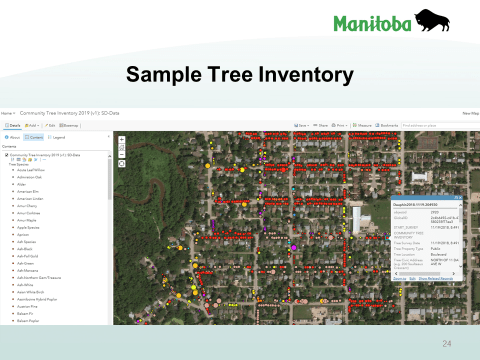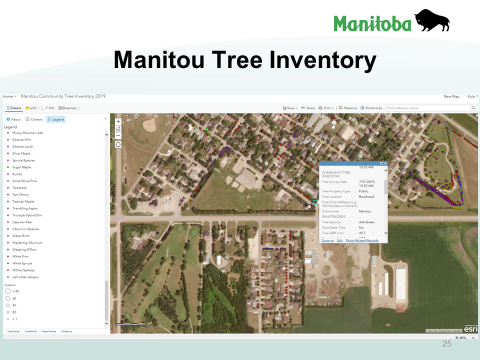I was very excited when the recent opportunity arose to represent the Prairie Region of Tree Canada’s Canadian Urban Forest Network (CUFN), an organization whose vision, mission, and core values align closely with my own. My educational background is in Environmental Studies, Forest Resources Technology, and Arboriculture and I have been working for the Province of Manitoba in the fields of forestry and urban forestry for 25 years. Fortunately, my passion for trees and the outdoors runs deep and I am just as excited to go to work today, collaborating with arborists and communities and providing educational outreach to the public, as I was when I began as a summer student, conducting silviculture surveys throughout the wilds of our vast province in the 1990’s.
When I moved into the world of urban forestry in Manitoba, I began to discover and become intimately familiar with the urban canopies of the many small towns and cities that dot our province. There is a strong sense of pride that these communities have for their trees. I believe it because it takes many years of care and dedication to cultivate and achieve these canopies in our part of the world. We work together to support each other in these endeavours and are fortunate to have a strong legacy of province-wide urban forest management initiatives, including the Dutch elm disease management program, which began with the disease’s introduction to Manitoba in the 1970’s. A close-knit community of professionals has evolved from this history, recently cemented by the formation of the Manitoba Urban Forest Council in 2019 and others such as Trees Please Winnipeg (a coalition of resident groups). My goal is to build a similarly strong network across the prairies. Our region shares a reality of harsh climates, limited tree selections, and scattered, isolated communities. I look forward to strengthening our connections and collaborations as we find more commonalities between us.
Manitoba’s Community Tree Inventory Initiative
Similar to many prairie towns and cities, Manitoba’s communities boast beautiful urban forests. Often times they are urban areas carved out of the boreal forest or islands of green on the expansive prairie grasslands. There are lush river-bottom ecosystems, aspen parklands, oak, ash, and softwood forests. Decades of planting efforts on both private and public lands have also resulted in protective shelterbelts, tree-lined streets and shaded parks and yards. These trees, however, are threatened by invasive forest pests and diseases and climate change. Constant maintenance and management is necessary to maintain the health of these valuable assets and an urban forest management plan is an essential tool for protecting this resource. The Province of Manitoba recognizes that the first step for communities in developing an urban forest management plan is to undertake a tree inventory. While many Manitoba communities are also beginning to understand the value of tree inventories (and ultimately urban forest management plans), they don’t necessarily have the internal capacity to develop and maintain such a database.
In 2017, Manitoba Agriculture and Resource Development’s Forestry and Peatlands Branch began developing a model to assist communities with the seemingly overwhelming task of building a community tree inventory. We tested various data collection programs and tools to determine the most efficient and user-friendly techniques and received feedback from arborists and public works staff in partner communities. The province now works with municipalities, Conservation Districts, schools, cities and towns, using ArcGIS Online (AGOL) in developing community tree inventories, which are stored within Manitoba’s organizational account. The Forestry and Peatlands Branch provides training and ongoing technical assistance, while the communities provide staff and equipment.
Ultimately, Manitoba’s community tree inventory initiative aims to help communities improve diversity, manage invasive species, and protect their important natural assets for generations to come, while simultaneously developing a comprehensive province-wide database of Manitoba’s urban trees.
For more information about this exciting project, please reach out to Manitoba’s Tree Line at 204-945-7866 or treeline@gov.mb.ca and we would be happy to help you.
Back to all articles

